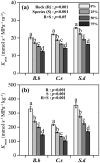A trade-off between leaf hydraulic efficiency and safety across three xerophytic species in response to increased rock fragment content
- PMID: 38245807
- PMCID: PMC10918055
- DOI: 10.1093/treephys/tpae010
A trade-off between leaf hydraulic efficiency and safety across three xerophytic species in response to increased rock fragment content
Abstract
Limited information is available on the variation of plant leaf hydraulic traits in relation to soil rock fragment content (RFC), particularly for xerophytes native to rocky mountain areas. In this study, we conducted a field experiment with four gradients of RFC (0, 25, 50 and 75% ν ν-1) on three different xerophytic species (Sophora davidii, Cotinus szechuanensis and Bauhinia brachycarpa). We measured predawn and midday leaf water potential (Ψleaf), leaf hydraulic conductance (Kleaf), Ψleaf induced 50% loss of Kleaf (P50), pressure-volume curve traits and leaf structure. A consistent response of hydraulic traits to increased RFC was observed in three species. Kleaf showed a decrease, whereas P50 and turgor loss point (Ψtlp) became increasingly negative with increasing RFC. Thus, a clear trade-off between hydraulic efficiency and safety was observed in the xerophytic species. In all three species, the reduction in Kleaf was associated with an increase in leaf mass per area. In S. davidii, alterations in Kleaf and P50 were driven by leaf vein density (VLA) and Ψtlp. In C. szechuanensis, Ψtlp and VLA drove the changes in Kleaf and P50, respectively. In B. brachycarpa, changes in P50 were driven by VLA, whereas changes in both Kleaf and P50 were simultaneously influenced by Ψtlp. Our findings suggest that adaptation to increased rockiness necessarily implies a trade-off between leaf hydraulic efficiency and safety in xerophytic species. Additionally, the trade-off between leaf hydraulic efficiency and safety among xerophytic species is likely to result from processes occurring in the xylem and the outside-xylem hydraulic pathways. These findings contribute to a better understanding of the survival strategies and mechanisms of xerophytes in rocky soils, and provide a theoretical basis for the persistence of xerophytic species in areas with stony substrates.
Keywords: drought acclimation; leaf hydraulic traits; leaf structure; rock fragments.
© The Author(s) 2024. Published by Oxford University Press. All rights reserved. For permissions, please e-mail: journals.permission@oup.com.
Conflict of interest statement
None declared.
Figures







References
-
- Abate E, Nardini A, Petruzzellis F, Trifilò P (2021) Too dry to survive: leaf hydraulic failure in two salvia species can be predicted on the basis of water content. Plant Physiol Biochem 166:215–224. - PubMed
-
- Baetens JM, Verbist K, Cornelis WM, Gabriëls D, Soto G (2009) On the influence of coarse fragments on soil water retention. Water Resour Res 45:W07408. 10.1029/2008WR007402. - DOI
-
- Bao WK, Pang XY, Li FL, Zhou ZQ (2012) A study of ecological restoration and sustainable management of the Arid Minjiang, River Valley, China. Beijing: Science Press. (in Chinese).
-
- Bartlett MK, Scoffoni C, Sack L (2012) The determinants of leaf turgor loss point and prediction of drought tolerance of species and biomes: a global meta-analysis. Ecol Lett 15:393–405. - PubMed
-
- Bartlett MK, Zhang Y, Kreidler N, Sun S, Ardy R, Cao K, Sack L (2014) Global analysis of plasticity in turgor loss point, a key drought tolerance trait. Ecol Lett 17:1580–1590. - PubMed
MeSH terms
Substances
Grants and funding
LinkOut - more resources
Full Text Sources
Research Materials

